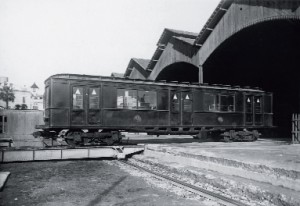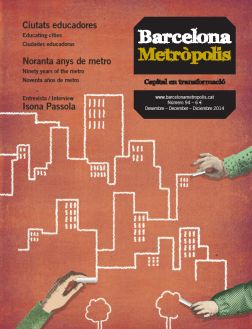On 30 December 1924, Barcelona’s first metro line was inaugurated; Gran Metro, predecessor to today’s Line 3, ran between Plaça de Lesseps, in the Gràcia neighbourhood, and Plaça de Catalunya. The new means of transport experienced a faltering start, low usage rates putting the company in a difficult financial position.
The genesis of Barcelona’s first planned metro, understood as an electric underground urban railway, coincided with profound, worldwide changes experienced in the field of urban transport during the early 20th century.
As a result of the emergence of electrical energy in developed societies, the end of the 19th century witnessed a progressive removal of animal and steam-driven vehicles from urban transport networks in favour of those using electricity. The new electric tram systems offered higher commercial speeds, a smaller environmental impact and much lower operating costs.
In addition, the widespread phenomenon of higher concentrations of the population in urban areas – prevalent then, and today continuing strongly still – created a growing need for more movement within cities under a state of continuous expansion. This trend made journeys by foot (the main means of travel until then) less feasible.
The phenomenon of migration triggered a growing need for more housing and new means of transport within a city that had already begun to annex neighbouring municipalities. Finally, with the development of the Cerdà Plan – which afforded continuity to areas lying between urban centres – transport systems came to be less a link between residential nuclei and more the focal points of urban mobility.
To manage and direct the growth of these areas, the City Council issued a call for tender, and in 1905 approved urban planner Léon Jaussely’s Link Plan, which substantially modified the Cerdà Plan with respect to land enjoyment and use. Jaussely proposed a division of urban areas into different zones in accordance with planned activities, and established green areas as a kind of firewall to separate them.
The plan also included tram networks and envisioned an underground electric railway, which would be the metro’s predecessor, as well as railway access routes and links. This aspect is described in the Tram and Railway Plan.

© Brangulí / Arxiu Nacional de Catalunya
Official visit to the construction work of the Gran Metro in December 1922.
Already at the beginning of the power system changeover for trams, the transport companies were unable to meet the growing demand for travel with sufficient service on some lines. High traffic density in certain central locations such as La Rambla, Plaça de Catalunya and Passeig de Gràcia led to an eventual search for a solution that would take the form of a separate underground urban electric railway capable of resolving congestion issues associated with public transport, which would also enable the proper planning road systems, a solution that had already been adopted in other locations with very good results.
The first plan
In an effort to meet this requirement, engineers Pau Muller and Gonçal Zaragoza drew up a plan for an underground railway, running on standard gauge track, to be called Ferrocarril Metropolitano Norte Sur de Barcelona. The plan called for 7.2 km of railway between Parc de la Ciutadella and La Bonanova. The route was to pass under Passeig de Colom, La Rambla, Plaça de Catalunya, Passeig de Gràcia, Carrer Gran de Gràcia, Plaça de Lesseps, Passeig de Sant Gervasi and Passeig de la Bonanova.
In taking charge of the project on behalf of the company Gran Metropolitano de Barcelona (GMB), industrial engineer Santiago Rubió i Tudurí reworked the original proposal. Head stations were modified and the tunnel built by the City Council on Via Laietana was purchased in 1908, thus adding a new branch line between Aragó and Correus to the original plan. The plan thus included sections that would be the precursors to the current L3 and L4 metro lines. This was the first underground metro tunnel built in Barcelona, and it remained unused for about 18 years until the opening of Line II between Aragó and Jaume I in 1926.
The lines already planned when works began in 1921 were the following:
— Line I, from Plaça de Lesseps to La Rambla (now L3).
— Line II, from Aragó to Correus (now L4).
— Line III, from Plaça de Lesseps to Sant Gervasi, Vallcarca and Horta (now L3, in part).
— Line IV, from Plaça de Lesseps to Sarrià, Les Corts, Sants, Hostafrancs, El Poble-sec, La Rambla, Parc de la Ciutadella, Estació de França and Correus (circular route).
— Line V, from Estació de França to La Rambla.

© Josep Domínguez / AFB
A coach from one of the first trains – manufactured by a Basque company – at the overground depot in Plaça Lesseps, the 1930s.
This GMB system covered the city’s main transport nodes and was a big change at a time when the tram system, in the midst of its most active expansion period, was starting to show signs of saturation and aging, both in terms of rolling stock and infrastructure, following more than twenty years of intensive use.
At the same time, in 1910 industrial engineer Ferran Reyes i Garrido undertook a plan for a railway link between all railway stations in existence at that time. The proposal included plans for building two major stations at Plaça de Catalunya that would also link with the Sarrià train.
The plan, called Ferrocarril Subterráneo SO-NE de Barcelona, Sans-San Martín, Enlaces y Estaciones Centrales, included wide Iberian gauge track and covered 7.4 km. It was submitted to the Spanish Government in 1912. Following the outbreak of World War I in 1914, the proposal fell into oblivion until 1920, when it was resuscitated under the leadership of the railway company Ferrocarril Metropolitano de Barcelona (FMB), which had just been incorporated.
As works began, FMB proposed and submitted a tender for seven new lines that would cover almost the entire city as it was at that time and be the precursor to the current system, along with lines created by GMB. The proposed lines were the following:
— The Sants-Sant Martí line, to be built between Sants and Plaça de Catalunya, with a provisional terminal station.
— The Lesseps line, with a link to Plaça de Catalunya with the Sarrià train, to be made an underground line with Iberian gauge track and a terminal in the station of the line under construction. It included a branch line between the Gràcia and Plaça de Lesseps stations.
— The Ronda line, from Plaça de Espanya to Plaça de Universitat via Paral·lel and the Rondes.
— The Plaça de Tetuan line, from Plaça de Universitat to Tetuan through Gran Via de les Corts Catalanes.
— The Sant Andreu Line, from Plaça de Tetuan to Plaça de Les Glòries through Gran Via, and as far as Sant Andreu beside Passeig de Valldaura and along Ribes highway.
— The Poblenou line, starting at the corner of Passeig de Sant Joan and Travessera de Gràcia, along Passeig de Sant Joan to Carrer de Pujades and from there to Pere IV and Carrer de la Selva de Mar.
— The Can Tunis line, starting at Plaça de Espanya and running along Gran Via de les Corts Catalanes to the Mare de Déu del Port district, L’Hippodrome de Can Tunis and the free port.
— The El Prat de Llobregat line, from Plaça de Espanya and along Gran Via de les Corts Catalanes to La Estació del Prat, owned by the MZA railway company, and from there to the airport.
These projects all preceded the opening of GMB’s Line I with the exception of the last, for which a tender was submitted soon thereafter, in 1925.

© Frederic Ballell / AFB
Work for the opening of Via Laietana in 1913, showing an alreadyconstructed small part of the two-way tunnel which covered the tracks from line II of the Gran Metro (Aragó- Correus) from 1926.
Line I of the GMB was opened on 30 December 1924, in an unfinished section, as only the section from Plaça de Lesseps to Plaça de Catalunya, with a length of 2.7 km and with two intermediate stations, Diagonal and Aragó, was put into service. The following stations were later put into service: Fontana, on 1 May 1925; Liceu, on 5 July 1925; the line between Aragó and Jaume I, on 19 December 1926.
With regard to the FMB lines, on 10 June 1926 the section between La Bordeta and Plaça de Catalunya opened under the name Ferrocarril Metropolitano Transversal, precursor to the current Line 1. It had a temporary station in Plaça de Catalunya until the completion of works to Sant Martí.
The metro’s operations experienced a faltering start: a low rate of citizen use caused the company serious financial difficulties. It should be noted that more than 170 million tram journeys had been made each year. The metro did not achieve the annual figure of 10 million journeys until the 1930s. Some observers of this phenomenon concluded that the Barcelona residents of that period did not like underground travel, but I think it would be more accurate to say that the offer was largely insufficient to meet the needs of a city like Barcelona. When a viable transport offer finally became available, the myth collapsed under its own weight.




